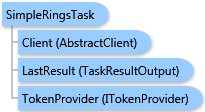
Simple Rings analysis using the Donut parameter option creates output ring-based trade/service areas that are in bands instead of concentric overlapping rings. For example, if three radii are entered with values of one, three, and five miles, three output bands would be created with 0-1, 1–3, and 3–5 mile trade/service area rings instead of 0-1, 0-3, and 0-5 mile rings. This will result in the creation of non-overlapping trade/service areas that will have significantly different results in subsequent analysis such as with Summary Reports.
Some applications of Simple Rings include the following:
- In most marketing applications, the point origins of ring-based analyses will be retail storefronts.
- Ring-based trade/service area analysis may be useful for studying the underlying market characteristics and demographics of the surrounding population.
The Simple Rings task trade/service areas differs significantly from the Drive Time task trade/service areas, which define these areas based on driving times or driving distances from the origin points over a street network. In highly urbanized areas, Drive Time may be a more logical choice for analysis since it takes into account the street network surrounding the store/origin points.
The result of this task is a ESRI.ArcGIS.Client.BACore.TaskResultOutput object, which is compatible with ArcGIS Server's mapping APIs. FeatureSet, MapImage, and an array of ReportInfo objects can be returned in it depending on task output options requested.
System.Object
ESRI.ArcGIS.Client.BACore.Client.AbstractTask
ESRI.ArcGIS.Client.BACore.Client.BATask<TResult,TEventArgs>
ESRI.ArcGIS.Client.BAO.Tasks.BAOTask<TResult,TEventArgs>
ESRI.ArcGIS.Client.BAO.Tasks.TradeAreas.SimpleRingsTask
Target Platforms: Windows 98, Windows NT 4.0, Windows Millennium Edition, Windows 2000, Windows XP Home Edition, Windows XP Professional, Windows Server 2003 family, Windows Vista, Windows Server 2008 family





